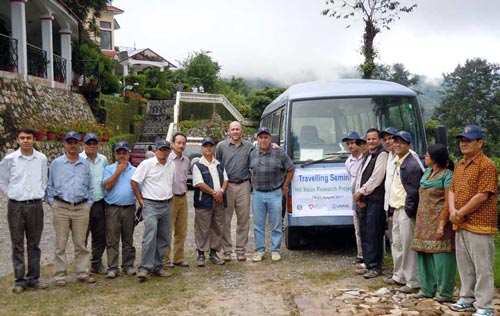 During 19-21 August 2011, a travelling seminar on “Maize Research and Development in the Hills of Nepal” was organized by the CIMMYT-led Hill Maize Research Project (HMRP), Nepal Agricultural Research Council (NARC), and the Nepal Department of Agriculture (DoA). The seminar offered policy makers first-hand information on maize varietal development, seed multiplication, technology dissemination, and HMRP’s efforts to improve food security and livelihoods of small-scale and disadvantaged farmers in the region. The 25 participants included representatives from the National Planning Commission, Ministry of Agriculture and Cooperatives, National Seed Board, NARC, DoA, donors (SDC and USAID), and NGOs.
During 19-21 August 2011, a travelling seminar on “Maize Research and Development in the Hills of Nepal” was organized by the CIMMYT-led Hill Maize Research Project (HMRP), Nepal Agricultural Research Council (NARC), and the Nepal Department of Agriculture (DoA). The seminar offered policy makers first-hand information on maize varietal development, seed multiplication, technology dissemination, and HMRP’s efforts to improve food security and livelihoods of small-scale and disadvantaged farmers in the region. The 25 participants included representatives from the National Planning Commission, Ministry of Agriculture and Cooperatives, National Seed Board, NARC, DoA, donors (SDC and USAID), and NGOs.
The first day included visits to participatory variety selection (PVS) and community-based seed production (CBSP) sites, and women’s CBSP cooperatives in Fulbari and Buluwa villages, 60km east of Kathmandu in the Kavre district. HMRP Leader, Guillermo Ortiz-Ferrara, described the work of HMRP, highlighting the increasing role of CBSP groups and the private sector in seed production and marketing, participation of multi-stakeholders, focus on gender equity and social inclusion, and continuation of farmers’ participatory adaptive research, including maize germplasm introduction and testing. Nanu Ghatani, Chairperson of the cooperatives, was one of the 45 members of the women’s cooperative and farmers who gathered to welcome the participants. She described the accomplishments of the CBSP cooperatives and their impact on enhancing food security; since the introduction of the new maize varieties and improved crop management technologies “maize yield has been doubled, and by selling improved seed, farmers could fetch NRs 35/Kg in 2010, when the price of maize grain was NRs 17/Kg. In value terms our land has been tripled,” she said. This has enabled women farmers to substantially increase their savings, she added. USAID representative Kip Sutton commended HMRP and partners for reducing poverty and food insecurity in the area, but participants also learned that there are further needs to improve yields, storage facilities, credits, inputs, and training.
 The following day featured a visit to the Hill Crop Research Program (HCRP), Kabre, Dolakha. Participants observed the onsite maize research and development activities, such as source seed production of improved maize varieties, and had the opportunity to interact with scientists at the station. N.P. Adhikari, Director of Crops and Horticulture, NARC, and D.B. Gurung, National Maize Coordinator, complimented the scientists for their accomplishments in maize research and development, both at the station and in the field.
The following day featured a visit to the Hill Crop Research Program (HCRP), Kabre, Dolakha. Participants observed the onsite maize research and development activities, such as source seed production of improved maize varieties, and had the opportunity to interact with scientists at the station. N.P. Adhikari, Director of Crops and Horticulture, NARC, and D.B. Gurung, National Maize Coordinator, complimented the scientists for their accomplishments in maize research and development, both at the station and in the field.
Station Chief, K.B. Koirala, gave a presentation on “Present status, priority, and challenges of maize research and seed production in HCRP Kabre”, highlighting that the work of the station has improved maize source seed production and quality, and reached thousands of poor farmers in the target area. The team then visited one of the farm cooperatives, which is conducting maize CBSP on 7ha. In later feedback, Adhikari commented that the seminar provided experiences which could only be appreciated by observations at the field level.
On the final day, participants visited the Hariyali Seed Company, a community-managed private seed company promoted by HMRP in Sindhupalchowk district. Company Coordinator, D.B. Bhandari, and the President of Sindhu-Tuki Seed Producers’ Cooperative, Gunda Bahadur Thami, outlined the progress of the cooperative so far; from the first maize PVS and intercropping trials in 2004, to the formation of a CBSP group in 2005, transformation into a cooperative in 2008, and culminating in the formation of the community-owned seed company in 2010, with maize seed being multiplied in 50ha.
The feedback from participants was very positive, with Bharat Upadhyaya, Executive Director of Nepal’s Center for Environmental and Agricultural Policy Research, Extension, and Development, commenting that “my 30 years of professional career in agriculture development in Nepal would have been incomplete if I would have missed this visit.” It was suggested that the event should be conducted annually during the main maize season.
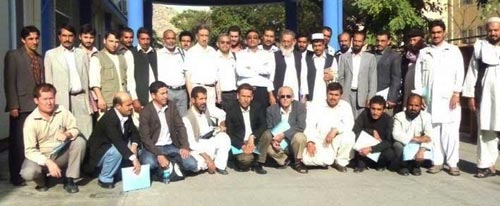

 During 19-21 August 2011, a travelling seminar on “Maize Research and Development in the Hills of Nepal” was organized by the CIMMYT-led Hill Maize Research Project (HMRP), Nepal Agricultural Research Council (NARC), and the Nepal Department of Agriculture (DoA). The seminar offered policy makers first-hand information on maize varietal development, seed multiplication, technology dissemination, and HMRP’s efforts to improve food security and livelihoods of small-scale and disadvantaged farmers in the region. The 25 participants included representatives from the National Planning Commission, Ministry of Agriculture and Cooperatives, National Seed Board, NARC, DoA, donors (SDC and USAID), and NGOs.
During 19-21 August 2011, a travelling seminar on “Maize Research and Development in the Hills of Nepal” was organized by the CIMMYT-led Hill Maize Research Project (HMRP), Nepal Agricultural Research Council (NARC), and the Nepal Department of Agriculture (DoA). The seminar offered policy makers first-hand information on maize varietal development, seed multiplication, technology dissemination, and HMRP’s efforts to improve food security and livelihoods of small-scale and disadvantaged farmers in the region. The 25 participants included representatives from the National Planning Commission, Ministry of Agriculture and Cooperatives, National Seed Board, NARC, DoA, donors (SDC and USAID), and NGOs. The following day featured a visit to the Hill Crop Research Program (HCRP), Kabre, Dolakha. Participants observed the onsite maize research and development activities, such as source seed production of improved maize varieties, and had the opportunity to interact with scientists at the station. N.P. Adhikari, Director of Crops and Horticulture, NARC, and D.B. Gurung, National Maize Coordinator, complimented the scientists for their accomplishments in maize research and development, both at the station and in the field.
The following day featured a visit to the Hill Crop Research Program (HCRP), Kabre, Dolakha. Participants observed the onsite maize research and development activities, such as source seed production of improved maize varieties, and had the opportunity to interact with scientists at the station. N.P. Adhikari, Director of Crops and Horticulture, NARC, and D.B. Gurung, National Maize Coordinator, complimented the scientists for their accomplishments in maize research and development, both at the station and in the field.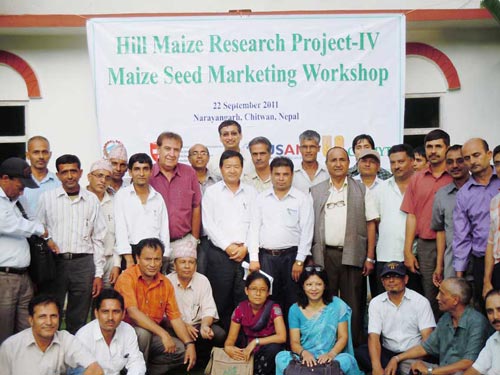
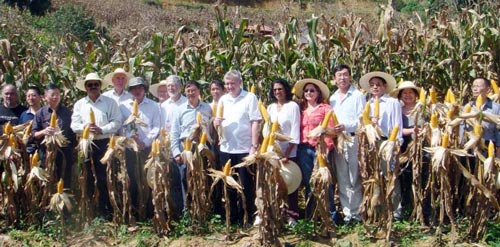
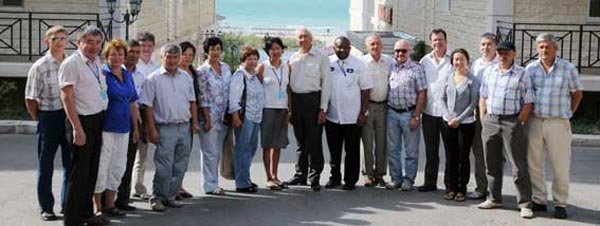
 SIMLESA is funded by the Australian Center for International Agricultural Research (ACIAR), and led by CIMMYT. It is being implemented in collaboration with the national agricultural research systems of Ethiopia, Kenya, Malawi, Mozambique, and Tanzania; the International Crops Research Institute for the Semi-Arid Tropics (ICRISAT); and Australian partners including the Queensland Department of Employment, Economic Development and Innovation (QDEEDI), Murdoc University, and the University of Queensland. These partnerships with Australian universities, as well as with universities in Africa, have been key to building capacity through short-term training and postgraduate fellowships for researchers. Adopting the Innovation Platform framework, further co-operation with a range of private and public sector organizations, NGOs, and famers’ organizations in Africa has meant the project has been able to quickly and effectively reach farmers on the ground with outputs such as varieties and technologies.
SIMLESA is funded by the Australian Center for International Agricultural Research (ACIAR), and led by CIMMYT. It is being implemented in collaboration with the national agricultural research systems of Ethiopia, Kenya, Malawi, Mozambique, and Tanzania; the International Crops Research Institute for the Semi-Arid Tropics (ICRISAT); and Australian partners including the Queensland Department of Employment, Economic Development and Innovation (QDEEDI), Murdoc University, and the University of Queensland. These partnerships with Australian universities, as well as with universities in Africa, have been key to building capacity through short-term training and postgraduate fellowships for researchers. Adopting the Innovation Platform framework, further co-operation with a range of private and public sector organizations, NGOs, and famers’ organizations in Africa has meant the project has been able to quickly and effectively reach farmers on the ground with outputs such as varieties and technologies.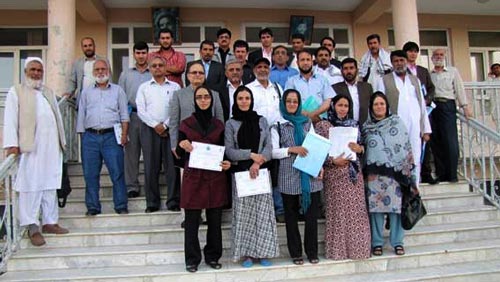
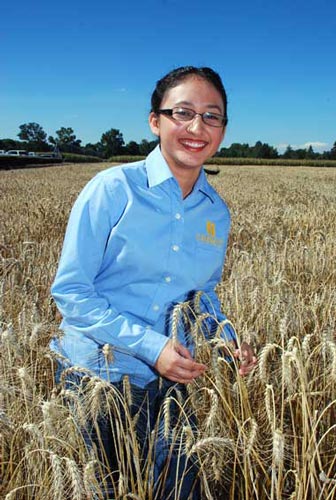 Marita Cárdenas, a member of the conservation agriculture team at CENEB, Ciudad Obregón, has been selected as one of 20 Latin American students to receive the International Plant Nutrition Institute (IPNI) Scholar Award for 2011. The prize recognizes Cárdenas’ work as part of her Master’s thesis under Iván Ortiz-Monasterio, focusing on phosphorus use efficiency using NDVI technologies (Greenseeker) to determine appropriate amounts of phosphorus fertilizer for wheat, and on wheat genotyping through phosphorus efficiency. Congratulations Marita!
Marita Cárdenas, a member of the conservation agriculture team at CENEB, Ciudad Obregón, has been selected as one of 20 Latin American students to receive the International Plant Nutrition Institute (IPNI) Scholar Award for 2011. The prize recognizes Cárdenas’ work as part of her Master’s thesis under Iván Ortiz-Monasterio, focusing on phosphorus use efficiency using NDVI technologies (Greenseeker) to determine appropriate amounts of phosphorus fertilizer for wheat, and on wheat genotyping through phosphorus efficiency. Congratulations Marita!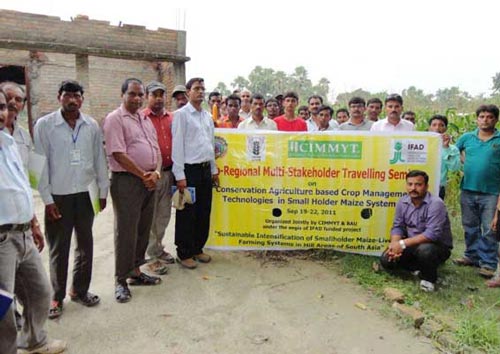 During 19-22 September 2011, Birsa Agricultural University (BAU), Jharkhand, India, hosted the Sub-Regional Multi-Stakeholder Travelling Seminar entitled “Conservation Agriculture Based Crop Management Technologies in Smallholder Maize Systems.” Organized jointly by BAU and CIMMYT-India, under the aegis of the IFAD “Sustainable Intensification of Smallholder Maize-Livestock Farming Systems in Hill Areas of South Asia” project, the seminar was attended by 37 scientists, extension agents and NGO representatives, students from Krishi Vigyan Kendra’s (KVKs) and BAU, and farmers from the three districts of Jharkhand.
During 19-22 September 2011, Birsa Agricultural University (BAU), Jharkhand, India, hosted the Sub-Regional Multi-Stakeholder Travelling Seminar entitled “Conservation Agriculture Based Crop Management Technologies in Smallholder Maize Systems.” Organized jointly by BAU and CIMMYT-India, under the aegis of the IFAD “Sustainable Intensification of Smallholder Maize-Livestock Farming Systems in Hill Areas of South Asia” project, the seminar was attended by 37 scientists, extension agents and NGO representatives, students from Krishi Vigyan Kendra’s (KVKs) and BAU, and farmers from the three districts of Jharkhand.